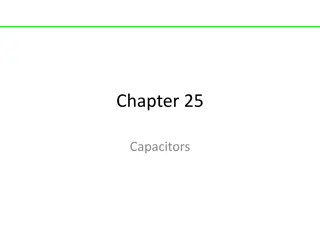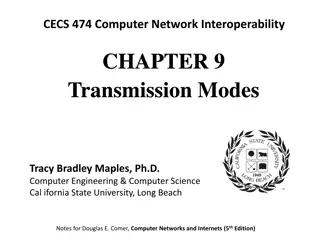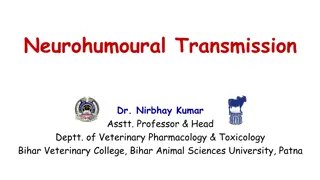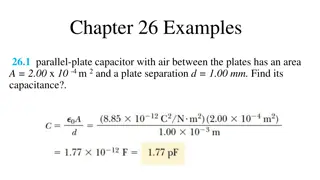Understanding Medium Transmission Line Capacitance Methods
Medium transmission lines, with lengths typically between 50-150 km and operating at voltages greater than 20 kV, require consideration of capacitance effects for accurate calculations. This article discusses key capacitance methods like the End Condenser Method and Nominal T Method, highlighting their advantages and limitations. Additionally, it covers ABCD parameters used for modeling transmission lines in a simplified manner.
Download Presentation

Please find below an Image/Link to download the presentation.
The content on the website is provided AS IS for your information and personal use only. It may not be sold, licensed, or shared on other websites without obtaining consent from the author. Download presentation by click this link. If you encounter any issues during the download, it is possible that the publisher has removed the file from their server.
E N D
Presentation Transcript
BINESWAR BRAHMA ENGINEERING COLLEGE DEPARTMENT OF ELECTRICAL ENGINEERING POWER SYSTEM-I Medium Transmission Line BISWANATH HAJOARY Asst. Professor Department of electrical Engineering
Medium Transmission Line The length and voltage of the line increase, the capacitance gradually becomes of greater importance Since medium transmission lines have sufficient length (50- 150 km) and usually operate at voltages greater than 20 kV, the effects of capacitance cannot be neglected. Therefore, in order to obtain reasonable accuracy in medium transmission line calculations, the line capacitance must be taken into consideration. The most commonly used methods (known as localised capacitance methods) for the solution of medium transmissions lines are : (i) End condenser method (ii) Nominal T method (iii) Nominal ?method.
End Condenser Method In this method, the capacitance of the line is lumped or concentrated at the receiving or load end. Let IR = load current per phase R = resistance per phase XL = inductive reactance per phase C = capacitance per phase cos R = receiving end power factor (lagging)
Limitations. Although end condenser method for the solution of medium lines is simple to work out calculations, yet it has the following drawbacks : (i) There is a considerable error (about 10%) in calculations because the distributed capacitance has been assumed to be lumped or concentrated. (ii) This method overestimates the effects of line capacitance.
Nominal T Method In this method, the whole line capacitance is assumed to be concentrated at the middle point of the line and half the line resistance and reactance are lumped on its either side. Therefore, in this arrangement, full charging current flows over half the line.
ABCD Parameters of Transmission Line ABCD parameters (also known as chain or transmission line parameters) are generalized circuit constants used to help model transmission lines. ABCD parameters are used in the two port network representation of a transmission line. It is used to simplify these complex calculations.
Long Transmission Line The transmission line are uniformly distributed over the entire length of the line. To obtain fair degree of accuracy in the performance calculations of long lines, the line constants are considered as uniformly distributed throughout the length of the line. The whole line length is divided into n sections, each section having line constants 1/n th of those for the whole line. (i) The line constants are uniformly distributed over the entire length of line as is actually the case. (ii) The resistance and inductive reactance are the series elements. (iii) The leakage susceptance (B) and leakage conductance (G) are shunt elements. The leakage susceptance is due to the fact that capacitance exists between line and neutral. The leakage conductance takes into account the energy losses occurring through leakage over the insulators or due to corona effect between conductors. Admittance = ?2+ ?2.
(iv) The leakage current through shunt admittance is maximum at the sending end of the line and decreases continuously as the receiving end of the circuit is approached at which point its value is zero. Analysis of Long Transmission Line (Rigorous method) Fig. 10.22 shows one phase and neutral connection of a 3-phase line with impedance and shunt admittance of the line uniformly distributed.























